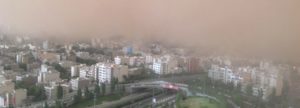November 10, 2017

An unusually high level of pollutants and sand enveloped many cities in Iran—north and south, east and west—the past week.
The sandstorms have also struck in Iraq, where flights to the Baghdad and Najaf airports were canceled for a few days, which reduced the numbers of people who could attend the annual Arbaeen mourning events in Najaf on November 7.
In Iran, the western and southwestern provinces of Kurdistan, Kermanshah, Ilam and Khuzestan reported the most air pollution.
The storms began October 28 and prompted the on-and-off closure of schools and government offices in many cities.
But sandstorms boosted pollution levels in distant other cities, including Tehran, Mashhad, Tabriz and Esfahan.
The high pollution levels last several days in many areas, not just the two or three days that is most common with such storms. In Tehran it lasted six days, in Esfahan seven.
Some locales reported pollution levels 30 times the acceptable count. Most communities reported an air quality index in the 100 to 150 range, which means the air is unhealthy for vulnerable groups like the young and the elderly. But the index in some areas rose above 150, which means unhealthy for all.



















